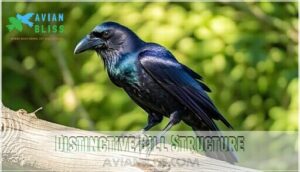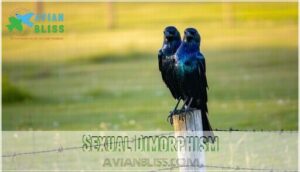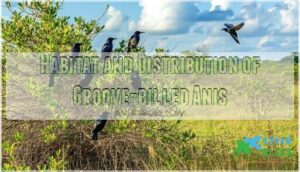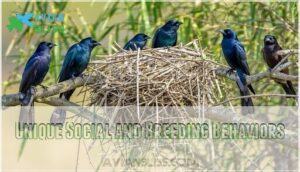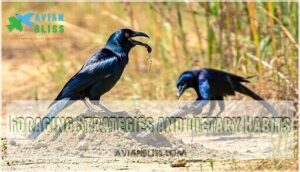This site is supported by our readers. We may earn a commission, at no cost to you, if you purchase through links.

Their glossy black feathers shimmer in the sun, and their heavy, grooved bills set them apart from their close relatives. Understanding how groove-billed anis live, communicate, and feed reveals a world of cooperation and adaptation, shaped by the landscapes they call home.
Table Of Contents
- Key Takeaways
- Physical Characteristics of The Groove-billed Ani
- Habitat and Distribution of Groove-billed Anis
- Unique Social and Breeding Behaviors
- Vocalizations and Communication Methods of Groove-billed Anis
- Foraging Strategies and Dietary Habits
- Frequently Asked Questions (FAQs)
- What does a groove-billed ani sound like?
- What is the behavior of a groove-billed ani?
- Is Ani a bird?
- How long do Groove-billed Anis typically live?
- Are Groove-billed Anis migratory birds?
- What are the main threats to Groove-billed Ani populations?
- How do Groove-billed Anis interact with other bird species?
- Can Groove-billed Anis be kept as pets?
- What predators threaten groove-billed anis?
- How do groove-billed anis respond to habitat loss?
- Conclusion
Key Takeaways
- Groove-billed anis stand out for their long tails, glossy black plumage, and distinctive grooved bills.
- These birds rely on strong social bonds, building communal nests and sharing parenting duties within cooperative groups.
- They thrive in open and semiopen habitats, adapting well to changes in landscape and often associating with cattle while foraging.
- Their varied calls and coordinated group behaviors help them communicate, avoid predators, and succeed in challenging environments.
Physical Characteristics of The Groove-billed Ani
If you’re curious about what sets the Groove-billed Ani apart, you’re in the right spot. Let’s look at some key features that make this bird stand out. Here are the main physical characteristics you should know.
Size and Shape
If you spot a Groove-billed Ani, the first thing you’ll notice is its long tail and sturdy frame that set it apart from most birds in the field. To help you visualize its body proportions and measurements, consider these features:
- About 33–36 cm in overall dimensions
- Rounded wing shape
- Tall, heavy bill size
- Distinctive tail length
- Glossy black physical description
Distinctive Bill Structure
Right after you notice that impressive tail, your eyes are drawn to the ani’s bill—a chunky, grooved tool that looks built for serious work. This bird’s curved bill isn’t just for show. It’s a specialized structure, shaped by evolutionary significance and feeding adaptations. Look closer and you’ll see deep bill grooves etched into the upper mandible, hinting at mandible strength and bill development.
Here’s what sets the groove-billed ani apart:
- Parrot-like bill shape
- Vertical grooves on the upper mandible
- Flattened bills for grasping prey
- Unique bill morphology for tough diets
Plumage Coloration and Patterns
Once you’ve taken in that striking bill, your attention shifts to the ani’s glossy black plumage, shimmering with hints of blue and green every time it catches the sun. This iridescent plumage, marked by bronzy reflections, isn’t just for show—it helps with camouflage in dense grasses. Feather structure plays a role in their color variation, especially during breeding.
Here’s a quick look at Groovebilled Ani identification:
| Color Pattern | Camouflage Role |
|---|---|
| Glossy Black | Blends in shade |
| Iridescent Blue | Disrupts outline |
| Bronzy Reflections | Breaks silhouette |
| Seasonal Variation | Adaptive cover |
Comparisons With Smooth-billed Ani
That glossy sheen isn’t the only thing that sets Groovebilled Ani apart. If you compare it with similar species, Smoothbilled Ani stands out for its taller bill—no grooves, just a smooth curve. Groovebilled Ani identification hinges on:
- Bill Grooves
- Vocal Differences
- Habitat Overlap
- Group Size
- Field ID challenges
These birds are often observed in small, gregarious groups. Species comparison is tricky, but listening for those liquid calls and spotting those grooves makes all the difference.
Sexual Dimorphism
When you’re scanning a flock of Groove-billed Anis, don’t bother searching for subtle differences between males and females—these birds look exactly alike. There’s no Plumage Differences or Size Variation to spot. Both sexes share identical avian morphology.
If you’re curious about Behavioral Roles or Mating Displays, you’ll find those are shared too, thanks to their genetic basis:
- Jet-black plumage
- Grooved bills
- Equal size
Habitat and Distribution of Groove-billed Anis
If you’re curious about where Groove-billed Anis make their homes, you’re in the right place. These birds have a knack for finding just the right spot in a wide range of settings. Let’s look at the main habitats and regions they choose.
Preferred Ecosystems
If you’re wondering where Groove-billed Anis feel most at home, think of places where tangled brush meets open fields and a little human activity doesn’t scare them off. These birds thrive in tropical and subtropical regions, choosing open and semiopen environments over dense forests. You’ll spot them weaving through bushy pastures, adapting to agricultural fields, or even near urban edges. Their Habitat Selection shows a knack for Urban Adaptation and resilience to Climate Impact, making them key indicators of Ecosystem Health and Conservation Efforts.
| Habitat Type | Vegetation Features |
|---|---|
| Semiopen country | Thick brush, grasslands |
| Lowlands | Dense thickets, scrub |
| Coastal areas | Thorn forests, mesquite |
| Urban edges | Overgrown pastures |
Geographic Range in North America
Across North America, Groove-billed Anis are most reliably found in the Texas breeding range—especially the South Texas Brush Country, Coastal Sand Plain, and Coastal Prairies regions. Seasonal range shifts bring small groups north and east along the Gulf Coast.
Their Mexican distribution is broad, but in the U.S., vagrant sightings pop up as far as Colorado and Florida. The Smooth-billed Ani was once a common resident in southern Florida.
Population trends show they’re uncommon, with numbers dropping in Texas over recent decades.
Breeding Territories in Texas
Ever wondered where Groove-billed Anis gather for nesting season in Texas? It’s not just anywhere—they stake out their territories in the dense thickets and brushlands of the lower Rio Grande valley, turning these wild spaces into lively communal homes.
You’ll find cooperative groups breeding in the South Texas Brush Country, Coastal Sand Plain, and Coastal Prairies regions. Territory size shrinks as nesting decline and habitat loss increase, making conservation efforts more urgent than ever.
Seasonal Movements and Migration Patterns
Isn’t it curious how Groove-billed Anis rewrite the map every season? Their Texas residency shifts with avian migration patterns, shaped by climate influence and habitat preferences. Here’s how their movements unfold:
- Northern movements contract the breeding range after summer.
- Post-breeding dispersal sends young and adults southward.
- Rare fall wanderers pop up along the Gulf Coast.
- Natal philopatry keeps some birds close to home, while others venture farther.
Their journeys reveal a shifting geographic distribution.
Global Distribution
You might be surprised to learn that Groove-billed Anis aren’t just local characters—they stretch their wings across nearly the entire length of the Americas. Their geographic distribution spans tropical and subtropical regions from southern Texas through Middle America and deep into South America.
Range expansion and shifting patterns often reflect habitat loss, climate change, and invasive species pressures. Despite these changes, their conservation status remains stable, thanks to adaptability in open fields, scrublands, and farmlands.
Unique Social and Breeding Behaviors
Groove-billed anis have some of the most interesting social habits you’ll find in birds. Their approach to nesting and raising young is truly a team effort. Here’s what sets their breeding behavior apart.
Communal Nesting Practices
When Groove-billed Anis settle down to nest, they turn teamwork into an art form, gathering in lively groups where every bird has a role to play. Their communal nest—a tangled bowl in dense brush—hosts multiple pairs, blending communal nesting behavior and cooperative breeding into daily life. What makes this setup fascinating?
- Nestmate relatedness shapes who helps whom.
- Egg recognition skills help sort out "who laid what," curbing brood parasitism.
- United nest defense thwarts predators, even if reproductive skew means not every Ani contributes equally.
Cooperative Breeding and Parenting
Building on their lively group nesting, cooperative breeding in groove-billed anis is all about shared parental care. Here, group size shapes each adult’s workload—helpers pitch in, lightening the load and boosting chick survival.
Egg ejection does occur, yet the communal nest fuels adaptability. Hormonal influence nudges older birds toward more effective roles, knitting their family unit together and highlighting just how flexible avian reproduction and nesting behavior can be.
Nest Construction and Structure
After all the teamwork that goes into raising their young, groove-billed anis bring just as much energy and cooperation to building their nests.
You’ll find them weaving twigs, leaves, and vines into a sturdy bowl-shaped nest about a foot wide. Nest placement matters—they choose low branches or shrubs, ensuring structural integrity.
The construction timeline is quick, often just days, thanks to coordinated nest building.
Egg-laying and Incubation Process
Once the nest is in place, the real teamwork begins as each bird in the group adds her own eggs to the mix and shares the work of keeping them warm. Communal Egg Laying leads to a clutch of up to twenty eggs, with notable Egg Variability.
Incubation Roles are shared, each adult taking turns during the roughly 13-day incubation period. This cooperation boosts Hatching Success and limits Nest Parasitism.
Nestling Development and Care
From the moment those tiny chicks hatch, the whole ani family springs into action, making sure every nestling gets the care it needs to grow strong. Hatchling development happens fast, with young leaving the nest after just 6–7 days.
Parental roles shift as all adults share feeding duties, boosting survival. Feeding habits evolve as nestlings grow, and by day 17, fledgling stage skills are clear.
You’ll notice nestling mortality drops thanks to this cooperative approach—an impressive example of parental care in birds and avian development.
Vocalizations and Communication Methods of Groove-billed Anis
Groove-billed anis have a wide range of sounds and signals they use to stay connected. Their calls and behaviors tell you a lot about how they interact with each other and their surroundings.
Here’s what you’ll find when you look closer at their ways of communicating.
Types of Calls and Songs
Imagine a bird whose voice can shift from gentle, bubbling whispers to sharp, urgent alarms in the blink of an eye. Groove-billed Anis use a diverse call repertoire, blending soft gurgles for daily chatter with harsh calls for warnings.
Song functions range from mate attraction to territory defense. You’ll hear duet singing between pairs, and even chick vocalizations. Regional dialects add local flavor to their bird vocalizations.
Vocal Patterns and Frequencies
Ever wondered how the Groove-billed Ani’s voice cuts through a thicket, shifting from a soft murmur to a sharp screech in just seconds? Their bird vocalizations are a study in contrasts. Groove-billed Anis use a wide Frequency Range, weaving together whistles, growls, and screeches. Song Complexity varies, with calls designed for group chatter or warnings. You’ll notice Regional Dialects in different flocks, showing Vocal Learning at work. These avian vocalizations help anis stay connected and alert, making their calls an essential part of survival in dense habitats.
- Call Types shift from gentle to harsh
- Song Complexity adapts for social needs
- Frequency Range covers low to high pitches
- Vocal Learning shapes Regional Dialects
Context-specific Vocalizations
If you’ve ever wondered what a bird is saying, the Groove-billed Ani’s calls are like a secret code, each one matched to a moment—whether danger, dinner, or a new arrival in the nest. Alarm calls trigger swift threat response, while Mating songs encourage pair formation.
Chick vocalizations signal hunger, and group cohesion depends on constant avian communication methods. Their bird calls reveal intricate avian behavior in every situation.
Non-vocal Communication Methods
Sometimes, words aren’t needed—these birds let their feathers and gestures do the talking. Groove-billed Anis rely on postural displays, bill communication, and allopreening signals to shape social behavior.
You’ll notice tactile cues like gentle pecks and visual signals such as wing spreading or head bobbing. These avian communication methods reinforce communal living arrangements and support cooperative breeding in birds, revealing the complexity of their non-vocal avian behavior.
Comparison With Other Cuckoo Species’ Vocalizations
What sets Groove-billed Ani apart in the Cuculidae crowd? Their call frequency range is higher (2.5–4.5 kHz) than most cuckoos. You’ll hear context-specific calls—brief, irregular, and gurgling, unlike the Common Cuckoo’s rhythmic “cu-coo.” Compare their vocal repertoire size—three to four main calls—with Asian Koels’ six.
Temporal call patterns shift with group activity, not just mating. Geographic call variation is subtle, yet these avian species descriptions reveal the diversity within the broader cuckoo family, Cuculiformes.
Foraging Strategies and Dietary Habits
Groove-billed anis are opportunistic feeders with a diet as varied as their social habits. You’ll find these birds employing clever foraging techniques that capitalize on their ground-dwelling lifestyle and cooperative nature.
Their eating habits shift with the seasons and reveal their important role in controlling insect populations across their range.
Preferred Food Sources
You’ll spot these birds munching on everything from crunchy beetles to juicy berries throughout their day. Their avian diet composition includes grasshoppers, spiders, and even lizards—showing true dietary adaptations.
Curious about their fruit preference or insect consumption? Check out how their menu shifts seasonally and with cattle association:
| Food Type | Example Items |
|---|---|
| Insects/Lizards | Beetles, grasshoppers, lizards |
| Fruits/Berries | Wild berries, small fruits |
Foraging Techniques and Behaviors
After exploring what Groove-billed Anis eat, let’s look at how these birds hustle for their next meal, using quick movements and sharp bills to snatch up insects and berries wherever opportunity strikes. Their foraging is a mix of Prey Detection and Cooperative Hunting, shaped by Diet Adaptations and Habitat Exploitation. You’ll notice them:
- Darting through grasses for insects
- Using teamwork to flush out prey
- Adapting feeding behavior to seasonal changes
Association With Cattle and Other Animals
When Groove-billed Anis are on the hunt, you’ll often find them tagging along with cattle, turning a simple grazing scene into a lively partnership that benefits both bird and beast. This connection highlights their social behavior and clever foraging in grasslands. Here’s how this symbiotic relationship works:
- Anis grab insects stirred up by cattle.
- They help with Cattle Parasite Removal.
- Habitat Overlap reduces Predation Risks.
- Interspecies Communication keeps both species alert.
Seasonal Variations in Diet
Just as their friendship with cattle keeps things interesting, these birds switch up their diet with each season, always finding a fresh way to fill their bellies.
In spring, Groove-billed Anis focus on insects, taking advantage of peak Insect Availability to meet their Nutritional Needs. Summer brings Fruit Abundance, prompting a shift to berries and other fruit.
Fall sees Dietary Shifts again, as their avian diet becomes more mixed, reflecting Regional Differences in feeding habits and foraging opportunities.
Role in Local Ecosystems
Within their habitat, Groove-billed Anis act as ecological catalysts. Their avian diet controls pests, disperses seeds, and fosters symbiotic relationships. As insectivores, they reduce crop damage. These birds also modify habitats by foraging and nesting, shaping environmental changes.
Their ecological impact includes:
- Pest control
- Seed dispersal
- Prey for predators
- Habitat modification
Frequently Asked Questions (FAQs)
What does a groove-billed ani sound like?
Ani vocalizations range from soft, liquid gurgles to harsh, squeaky calls. Their PITtooee notes sound like whistles or falling screams.
Each call meaning reflects social behavior, with song complexity and sound variations revealing group dynamics and habitat adaptation.
What is the behavior of a groove-billed ani?
Group dynamics shape Groove-billed Ani behavior—these birds form tight social hierarchies, practice cooperative hunting, and share parenting.
Their play behavior and predator evasion strategies reflect complex animal behavior, making their social behavior a standout in bird biology.
Is Ani a bird?
Picture a flock of dark, glossy birds weaving through tall grass—these are anis.
Classified as avian species and related to cuckoos, their evolutionary lineage, adaptations, and biology set them apart within the bird world.
How long do Groove-billed Anis typically live?
Most wild birds in this group live about 4–8 years. Lifespan Factors include Habitat Quality, Predation Impact, and Disease Influence. Captivity Lifespan may be longer.
Groovebilled Ani biology reflects typical avian life cycle and population trends.
Are Groove-billed Anis migratory birds?
Like a band with unpredictable tour dates, these birds show partial migration. Migration triggers include seasonal changes, causing dispersal patterns southward.
Some display nomadic behavior, while others stick around, showing habitat fidelity within their geographic distribution and habitat preference.
What are the main threats to Groove-billed Ani populations?
Habitat loss, pesticide use, and climate change threaten populations by reducing nesting sites and food. Invasive species and human disturbance disrupt their social breeding.
Conservation status remains stable, but avian conservation efforts are essential as environmental changes impact survival.
How do Groove-billed Anis interact with other bird species?
Like unwelcome guests at a crowded table, these birds often face mobbing from neighbors. Interspecies competition, predator avoidance, and occasional cooperative relationships shape their communal bird behavior, especially when comparing bird species sharing similar habitat and resources.
Can Groove-billed Anis be kept as pets?
Keeping Groove-billed Anis as pets isn’t suitable. Legal restrictions protect these birds, and their complex social behavior, habitat needs, and wild instincts don’t translate to captivity.
Observing their cooperative nature in the wild offers richer insight into bird behavior.
What predators threaten groove-billed anis?
Even the best nest-keepers can’t duck danger forever—snakes, hawks, and mammals raid ani nests for eggs or young, while adults face threats from raptors.
Habitat impact and loss intensify predator avoidance challenges, driving avian conservation and ecosystem efforts.
How do groove-billed anis respond to habitat loss?
You’ll find adaptation strategies like diet changes or shifting ranges, but territory reduction often leads to population decline.
Conservation efforts in avian conservation matter, since ongoing habitat loss and environmental changes impact these birds’ future survival and adaptation.
Conclusion
Imagine a crowd so lively, every bird crackles with purpose—this is the groove-billed ani’s world, more vibrant and surprising than any parade.
In the weave of thickets and sunshine, you glimpse intelligence at work: families building, parents sharing, all voices echoing through tall grass.
It’s a reminder that community makes the wild strong and strange. Let curiosity guide you close, and you’ll see how these birds turn the ordinary into pure, untamed wonder.
- https://www.audubon.org/field-guide/bird/groove-billed-ani
- https://www.mexican-birds.org/groove-billed-ani/
- https://en.wikipedia.org/wiki/Groove-billed_ani
- https://app.birda.org/species-guide/3842/Groove-billed_Ani
- https://repository.si.edu/server/api/core/bitstreams/977738cf-77ec-443f-9877-9dea321a370e/content


